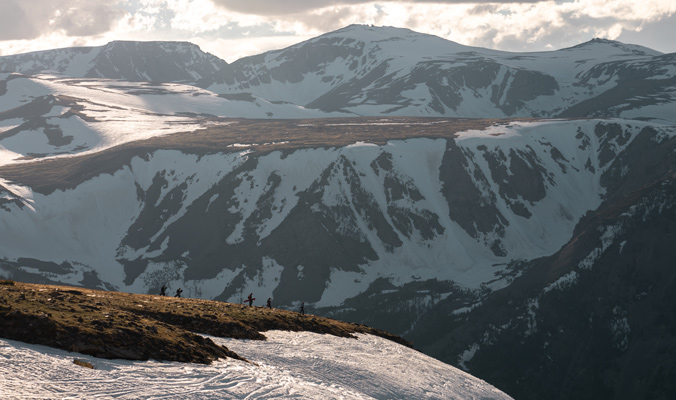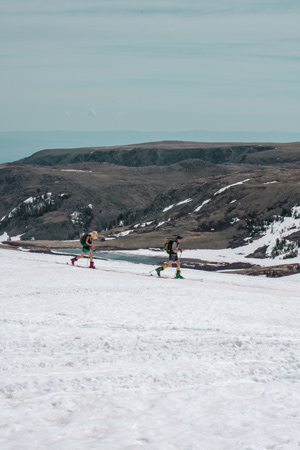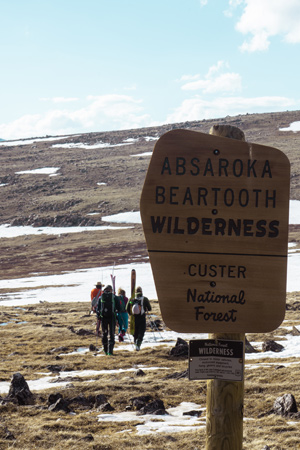
Skiers walk above Rock Creek with Mount Rearguard and Beartooth Mountain looming in the distance. [Photo] Anthony Pavkovich
By the time we were finished gearing up, the gate’s parking area was reaching capacity. Cars, snowmobile sleds, and tourists lined the road for a half-mile. We packed swiftly with hopes of heading for the boundary of the 40-year-old Absaroka Beartooth Wilderness and the solitude still protected there. North of the road and the wilderness line, alpine tundra spills down into the deep, glacial drainage of Rock Creek. This entrance to the popular and road-accessible Rock Creek Headwall was empty that morning, except for the occasional skier meandering across the plateau.
That quiet is the legacy of Montana’s Senator Lee Metcalf, who was instrumental in passing the 1964 Wilderness Act and who was an outspoken advocate for the Absaroka Beartooth Wilderness. Because of his timely work, this portion of the Beartooths was permanently conserved in order to provide a quiet space for backcountry recreation, the kind I was in search of.

Kacy Senger and Charlie Firer make their way toward the High Lakes WSA. [Photo] Anthony Pavkovich
But as of yet, no permanent strategy has been developed and over the last decade, more powerful snowmobiles and a higher user density have caused the amount of motorized use to skyrocket past historic levels, causing conflict between motorized and non-motorized users in this area.
The Forest Service—charged with ensuring that tundra and lakes within the High Lakes WSA remain protected—is looking for solutions to the area’s overuse in the form of seasonal closures for motorized use or an outright ban on snowmobiles. Being under review for Wilderness status has protected the area from additional road building and resource extraction, and the Wyoming Wilderness Act has guided the Forest Service in the decision to prohibit summer-based motorized use and potentially limit the amount of snowmobile use in winter. Still, no restrictions have yet to be formalized.

Melissa DiNino, Zach Altman, Kacy Senger and Charlie Firer cross into the Absaroka Beartooth Wilderness on their way to the Rock Creek Headwall. [Photo] Anthony Pavkovich
In mirroring this spirit of compromise, our group’s skintrack conversation changes from noise complaints to brainstorming possibilities as we walk deeper into the winter wilderness. The Shoshone National Forest—which neighbors us as we skin along—is currently going through the process of planning winter travel. They’ve designated some areas for motorized use while others are set aside for human-powered recreation and habitat protection. And so we discuss the possibilities of strategic planning for multiple user groups in the future and how we think it will affect trail use in the High Lakes WSA based on what has happened around us.

Zach Altman chases the last line of the day in the Absaroka Beartooth Wilderness. [Photo] Anthony Pavkovich
Beartooth Pass is one of the few opportunities for road-accessible, non-motorized winter recreation, but due to ease of access, user conflict is more prevalent. So it’s through this upcoming comment period that the winter landscape will take shape and multiple voices and motivations will be heard for both motorized and non-motorize recreation.
As we slipped into the steeps of the Beartooth Wilderness, our last conversation is of reverence and awe for this wild place before dropping into grin inducing turns toward the valley below. We look forward to finding a place of compromise where others can enjoy the beauty of this landscape, as we were able to this spring weekend in May.
—
To get involved, please sign up for action alerts from Winter Wildlands Alliance and view the Shoshone National Forest’s travel planning page. This fall, there will be an open comment period where skiers have a unique opportunity to speak up and advocate for quiet recreation in the region.










AT setups are a form of mechanized travel and therefore are banned in wilderness.
I don’t think you properly explained how snowmobiles and skiers are in ‘conflict’. The noise is the only issue? Seems kinda like you’re just trying to hog the area for yourself. A little high & mighty don’t you think?
Limiting access !== proper land management. Not everyone is capable of strapping on a touring setup and traveling under their own power. In a world where screens are taking over our lives, we should be promoting access for all people, regardless of form. I understand the need for access closures due to wear on the environment, but responsible over snow travel has minimal impact.
-AN avid skier AND snowmobiler
I agree that the more responsible you can be individually the less impact we will have overall. But I have a hard time buying that snow machines and skis with skins have similar environmental impacts.